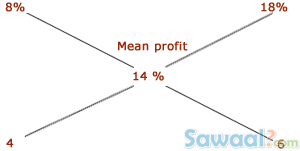Alligation or Mixture Questions
FACTS AND FORMULAE FOR ALLIGATION OR MIXTURE QUESTIONS
I. Alligation : It is the rule that enables us to find the ratio in which two or more ingredients at the given price must be mixed to produce a mixture of a desired price.
II. Mean Price : The cost price of a unit quantity of the mixture is called the mean price.
III. Rule of Alligation : Suppose Rs.x per unit be the price of first ingradient mixed with another ingradient (cheaper) of price Rs.y per unit to form a mixture whose mean price is Rs. z per unit, then
Quantity of cheaper : Quantity of dearer
= ( C.P of dearer - Mean Price ) : ( Mean Price - C. P of cheaper )
= ( x- z ) : ( z - y )
IV. Suppose a container contains x units of liquid from which y units are taken out and replaced by water. After operations , the quantity of pure liquid = units.

 Aptitude and Reasoning
Aptitude and Reasoning General Knowledge
General Knowledge Puzzles
Puzzles Interviews
Interviews Technical
Technical Certifications
Certifications Exams
Exams Job Roles
Job Roles True or False
True or False Exams
Exams Login
Login Sign Up
Sign Up



